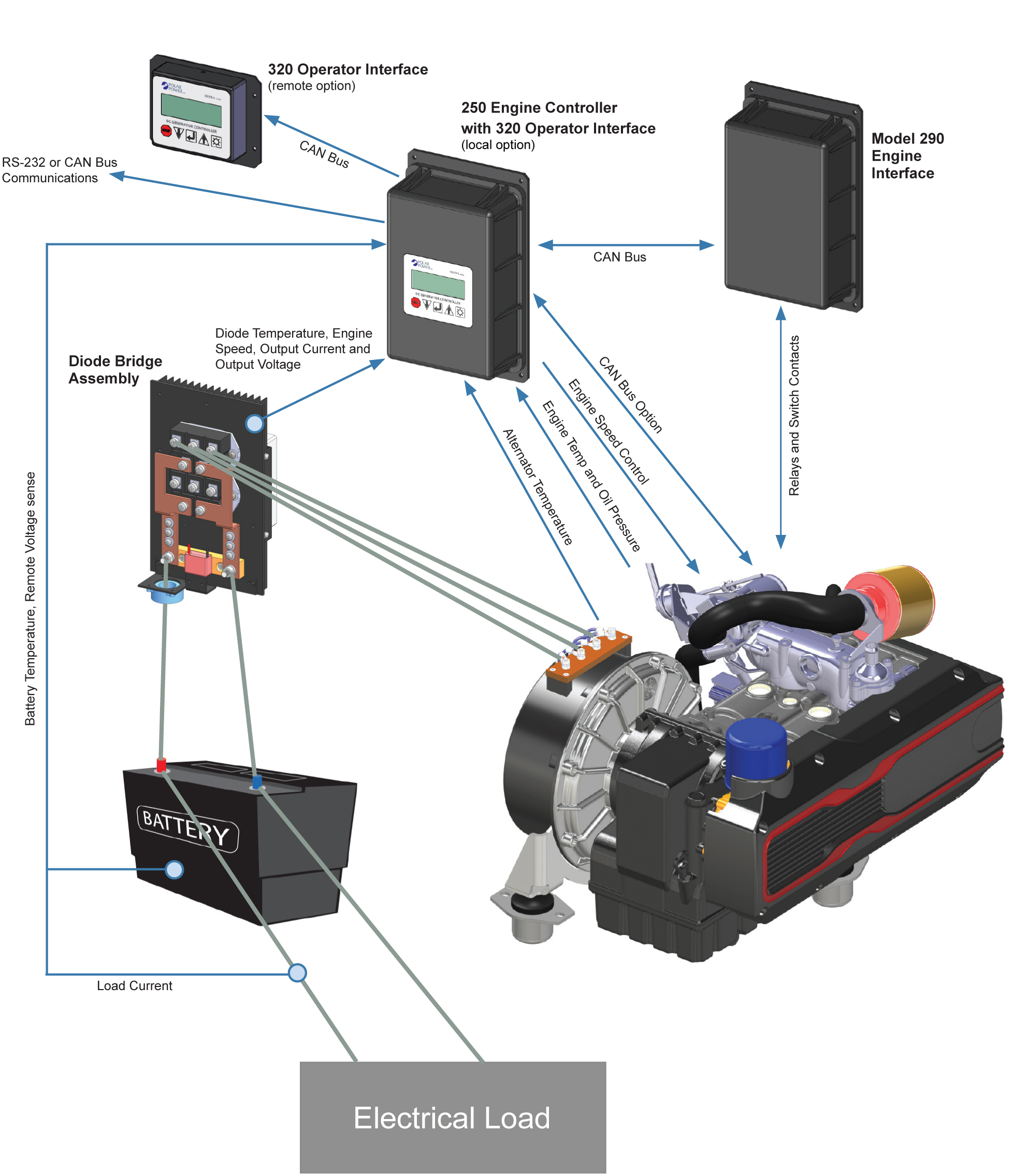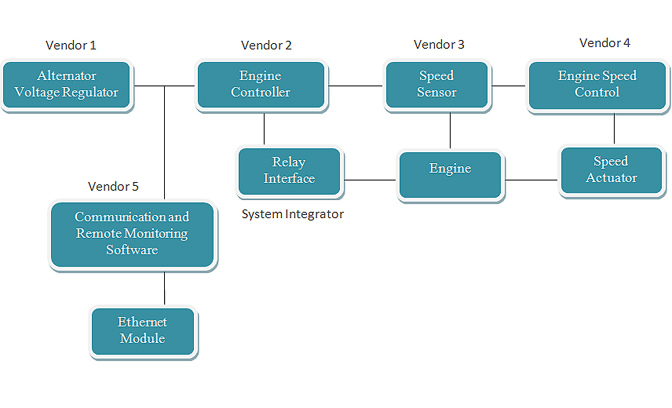The Supra Control System Integrates
- Engine Control
- Alternator Voltage Regulation
- Auxiliary Power Inputs
- Operator Interface
- Remote Site Monitoring and Communications
The Supra Model 250 System is a highly integrated control solution that will improve the reliability, serviceability, and remote controllability of DC generator power systems. The Supra Controller can control power to DC loads and serve as a fuel based programmable battery charging system.
Supra’s high level of circuit integration eliminates separate and independent control modules, simplifying the wire harness and eliminating the typical conflicts between modules integrated from different manufactures.
The Supra Controller based DC generator system can be: remotely controlled, monitored, calibrated, and tested, through an industrial modem, cell phone modem, or Ethernet. Communication is accessible locally with a PC Laptop or remotely through the Internet to facilitate site support and reduce costly visits to the site.
The Supra provides a complete log of alarms and operating parameters at the completion of a charge cycle or shutdown due to a fault condition. Alarms can be reset and the generator exercised remotely to help identify potential problems before scheduling a site visit. If an unscheduled maintenance is required, the technician can arrive at the site prepared, reducing the need for a second visit.
The Supra facilitates Hybrid Systems incorporating other sources of power including solar, wind, hydro, and utility.
All connections to the controllers are through Amp/Tyco Circular C type connectors facilitating onsite repair through controller swapping (plug and play).
The controller circuits were designed to meet the most stringent Military and Telecommunications requirements for EMI, EMP, and Ripple.
The Supra Controller can meet the requirements of any type of grounding requirement: negative, positive, or float.
Supra Advantages
1. Optically isolated RS 232 and CAN bus communications allow the generator to be controlled (locally or remotely) through a PC computer with Polar’s GUI or the customer’s own CAN bus.
2. Precision battery charging using control of both the voltage and current output. Battery charging using a single parameter of voltage control is insufficient because small milli-volt changes can cause undesirable, large current fluctuations
3. User configurable battery charging algorithms for different battery technologies. User configurable: current limit in bulk charge, temperature compensation curves, differentiation of load current and battery charge, and float voltages.
4. Control of Engine: RPM, starter motor, glow plugs, choke, fuel racks, fuel and engine block heaters, and cooling fans. Accurate monitoring of temperatures, pressures, coolant, and fuel levels.
5. Digitally controlled variable parameters: Digital control allows the generators, voltages, currents, engine speeds, and sensor calibrations to be remotely calibrated. All potentiometers were eliminated
6. Set points and recalibration can be performed remotely through the Internet, RS 232, Ethernet, or Cell Phone Modem using Polar’s GUI interface.
7. Software is field upgradeable.
8. 10 bit A/D converters and optically isolated linear amplifiers provide accurate voltage, current, fuel level, oil pressure, temperature, and engine speed measurements.
9. Sensor and communications ports are isolated, so the failure of an input sensor or communications port will not contribute to system conflicts and issues.
10. High immunity to electrical noise. Sources of noise include the starter motor, spark plugs, lightning, coupling of AC sources, cell phone transmissions, microwave, and radar transmissions.
11. Very low conductance and radiation of EMI: A clean DC Power Source is incorporated for the provisioning of sensors, field coils, and actuators with a resultant effect of a reduced EMI source. This is unlike other controller manufacturers, who typically use an unfiltered PWM source of power. Polar Power also increases EMI suppression by housing the three models 250, 290 and 320 in sealed Aluminum enclosures.
12. Polar’s unique circuit provides reliable operation in floating, positive, or negative ground systems. Polar uses switching power supplies to isolate both the positive and negative inputs. Most other controllers use a lower cost 3-pin voltage regulator that creates problems when moving between positive and negative ground systems.
13. The power supplies input and output signals and is fully isolated for up to 1500 Volts, via opto and galvanic couplers. The Supra Control System can tolerate most Hipot testing with controls connected in place.
14. Superior high voltage and current surge immunity from lightning, alternator surges, and load dumps with active voltage clipping circuits.
15. Supra’s microprocessor and relays are able to operate under low voltage conditions during engine cranking with a starting battery in poor condition.
16. AMP / Tyco Circular C type connectors are used to maintain a high degree of reliability and provide ease of field service. Signal pins are gold plated and power pins are silver plated, providing low maintenance operation in high humidity, salt fog, and sandy environments.
17. Model 250 and 290 enclosures are gasket sealed to IP64.
18. Conformally coated circuit boards: all components are soldered in place, except for fuses in the Model 290 module.
Supra Control System
The advantages of Polar’s highly integrated control system:
-
- No conflicts with Reference/Calibrations
- Wiring harness is very simple
- One vendor is responsible for the configuration management of hardware and software
- Plug-and-play for troubleshooting and repair
- All electronic components have extended temperature performance
- Lower-cost for a completely configured system
Competitor/Old
Disadvantages with multiple modules from various manufacturers in the same generator system:
- Reference/Calibrations (i.e. voltage, current, engine speed) will be different from module to module
- Connector systems will be different
- Wiring harnesses are larger and more complicated
- Configuration control is limited as various vendors make changes to their product
- Component and assembly costs are significantly higher
- For repairs and troubleshooting changing wires on terminal strips in the field presents problems as there is always the possibility of reversing wires








